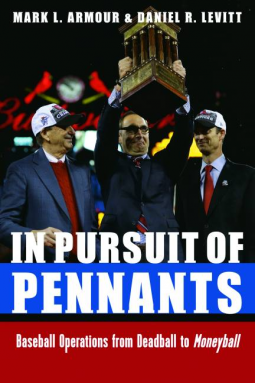
In Pursuit of Pennants
Baseball Operations from Deadball to Moneyball
by Mark L. Armour, Daniel R. Levitt
This title was previously available on NetGalley and is now archived.
Send NetGalley books directly to your Kindle or Kindle app
1
To read on a Kindle or Kindle app, please add kindle@netgalley.com as an approved email address to receive files in your Amazon account. Click here for step-by-step instructions.
2
Also find your Kindle email address within your Amazon account, and enter it here.
Pub Date Apr 01 2015 | Archive Date May 21 2015
Description
The 1936 Yankees, the 1963 Dodgers, the 1975 Reds, the 2010 Giants—why do some baseball teams win while others don’t?
General managers and fans alike have pondered this most important of baseball questions. The Moneyball strategy is not the first example of how new ideas and innovative management have transformed the way teams are assembled. In Pursuit of Pennants examines and analyzes a number of compelling, winning baseball teams over the past hundred-plus years, focusing on their decision making and how they assembled their championship teams.
Whether through scouting, integration, instruction, expansion, free agency, or modernizing their management structure, each winning team and each era had its own version of Moneyball, where front office decisions often made the difference. Mark L. Armour and Daniel R. Levitt show how these teams succeeded and how they relied on talent both on the field and in the front office. While there is no recipe for guaranteed success in a competitive, ever-changing environment, these teams demonstrate how creatively thinking about one’s circumstances can often lead to a competitive advantage.
Advance Praise
“Armour and Levitt have given the reader an inside look into the different cultures and challenges facing professional sports executives. Their management styles might differ, but the objective never changes: ‘Be a consistent winner.’”—Pat Gillick
“A rare combination of a must-have reference book and engaging storytelling by distinguished baseball historians Armour and Levitt.”—Vince Gennaro, president of the Society for American Baseball Research and author of Diamond Dollars: The Economics of Winning in Baseball
“This is an interesting, well-written, and well-researched examination of a behind-the-scenes look at how certain winning clubs have been constructed by notable baseball executives and the philosophies employed.”—Tal Smith, longtime baseball executive
“A great source of well-researched front office stories. . . . Armour and Levitt give an insider’s look at the teams’ efforts to innovate in this highly competitive industry.”—Sig Mejdal, director of Decision Sciences for the Houston Astros
“If Moneyball is the tale of how a modern front office works, In Pursuit of Pennants is the prequel that ably sets the stage.”—Jonah Keri, author of the bestselling The Extra 2% and Up, Up, and Away
Available Editions
| EDITION | Hardcover |
| ISBN | 9780803234970 |
| PRICE | $34.95 (USD) |
Average rating from 8 members
Featured Reviews
 Budd B, Media/Journalist
Budd B, Media/Journalist
The most fundamental question in major league baseball might be this one: How do you win games?
Obviously, scoring more runs than the opposition on a consistent basis is a good start. But, how is that accomplished?
It's a tougher question than many might think. After all, if it were easy, everyone would be doing it ... and every team would wind up at .500. Not only that, but the rules about putting together a winner in baseball keep changing.
Mark L. Armour and Daniel R. Levitt have taken on the big job of explaining how that task has changed in the past 110 years or so. No wonder the text of "In Pursuit of Pennants" checks in at more than 400 pages.
The short answer is that as the game has become more complicated, and more financially rewarding, the number of people in charge of such decisions has grown almost exponentially. We've gone from one or two people to dozens and dozens over the years as the stakes have gotten bigger.
That was a slow process, of course. This book starts in the 1890s, when baseball was just starting to move past the original concept where the captain was also a recruiter of local talent, and the games really were my town's best against your town's best. Before long, though, owners such as Barney Dreyfuss of Louisville and Pittsburgh started to take a role in putting together the team. That got to be a big job, so managers received a larger role in selecting the roster.
Eventually, the business of the game grew a bit, and the owners needed someone to oversee the ball club. That spot eventually became known as a general manager. Naturally he needed assistants as the organization grew in size.
Every so often, something came along to change the rules when it came to player acquisition. Let's list some of them - minor league teams became part of a major league organization, African-Americans (and later Latins and Asians) entered the talent pool, the amateur draft came long, the league expanded, and free agency arrived. It wasn't always easy to keep up.
The book, then, becomes something of a collection of case studies of certain teams in particular eras. The great Yankee teams and the Big Red Machine are profiled, as you might expected. But there are surprising choices as well. The Kansas City Royals, for example, rarely missed a step when they entered the American League in 1969, and became a constant contender in about seven years.
It's often very interesting to see how teams got better. For example, the Boston Red Sox of the early 1960s were rather awful. General manager Dick O'Connell cleared out many of the veterans, put in some talented youngsters, and watched the win-loss record slowly improve. The surprise 1967 pennant was followed by years and years of winning seasons, and it's great fun (at least for those who are familiar with the team) to see how things were put together in hindsight.
The narrative concludes in the present day, where teams like the San Francisco Giants used the latest analytics and technology advances to seek out an edge on the competition. It seems to be working, based on their record of success lately.
Credit goes to Armour and Levitt for some comprehensive research into the subject. There are plenty of interesting facts presented along the way. Drawbacks are few in number. It can be a little dry in spots, and a little editing would have gotten the manuscript down a bit to a slightly more readable length.
Plus, "In Pursuit of Pennants" obviously is designed with the good-sized baseball fan in mind. In other words, members of the Society of American Baseball Research will thoroughly enjoy this. Others might not open this volume, but it's nice that such a smart work about an important aspect of the sport is there for the reading by those who wish to get an advanced education on the subject.
 Andy L, Reviewer
Andy L, Reviewer
I am a casual baseball fan. I catch a few games every year, usually watch the LCS and World Series, and could probably name the MLB division leaders. I understand the basics and a few of the nuances of the game, but I don’t have any rosters committed to memory, and would be hard-pressed to explain the intricacies of the Infield Fly Rule.
I found this book to be among the best and worst of the baseball books I have ever read. The first half of the book is horrible, and I almost put it down several times. The second half was great, among the best books I have read on sports.
===The First Half of the Book ===
* It is certainly full of “history”, but it is the worst kind of history. There are plenty of names, dates, places, but little explanation of context of why I care. If you are interested in the purchase of players by the Pittsburgh Pirates (Carson Bigbee from Tacoma in 1916, Kiki Cuyler from Bay City Mississippi in 1921), then this is your book. I never heard of either of these guys, and the book didn’t tell me why I should have, or what was important about the transactions. These are just the type of facts that I will read and promptly forget.
* The narrative is just about unreadable. Consecutive paragraphs will skip from decade to decade, and it was tough to comprehend what year I was reading about.
* There was no story line. There were plenty of details about who was traded to who, but little context provided for why it mattered. I was impossible to build an understanding of how these teams were managed, or what constraints they operated under.
* In short, the first half of the book was a mess. There were lots of facts, but no context, and I had no clue why I was reading any of this material. There was nothing that I would remember, and I had no understanding of early baseball management or strategy for team building.
=== The Second Half of the Book ===
* Starting with about the 1950’s, the book was completely different. It began to tell a story, put facts into context, and actually explain how and why teams were built the way they were. The writing becomes much more precise, stays on topic, and actually tells a story. This part of the book was an absolute joy to read.
* Several teams are profiled. The Cincinnati Reds during the “Big Red Machine” days of the 1970’s, the Saint Louis Cardinals, The Yankees, Blue Jays, Dodgers and a few others. In each of these cases, we see how the front office approached baseball, including free-agents, the draft, farm systems and trades. The constant struggles of the General Manager come to light- win today or develop for tomorrow; go with proven (and expensive) veterans or young talent; pay high salaries or invest in the development leagues;
* There are excellent discussions of statisticians versus “old-time” scouting. The book picks up where “Moneyball” left off, showing how the various teams have chosen between each of these strategies, and how some of the more successful teams have learned to integrate both approaches.
* There were several detailed looks at front offices and General Managers. Pat Gillick is profiled for his work at a number of teams. The book delivers a look at how this man developed several teams, including the expansion Blue Jays, into successfully run front offices. We also get to see successful draft and development strategies in action- such as the SF Giants bringing along Matt Cain, Jonathan Sanchez, Tim Lincecum and Madison Baumgarner all within a few years.
=== Summary ===
I hated and loved the book. The beginning half of the book was horrible. It needed a good editor, some serious rewriting, and a reason to even exist. The latter part of the book, starting with the section on the rise of the General Manager was much better. Towards the end, as the abilities and strategies of specific team’s front offices are discussed, the book is excellent, one of the best I have read.
I would think most any baseball fan would enjoy the second half of the book, and I would recommend it. Only a true baseball historian would find any enjoyment at all in the first half. I gave it 4/5 stars, but it is really 1 star for the first half and 5 for the second.
 Marc R, Reviewer
Marc R, Reviewer
A well researched, in depth study of how teams have been built, and by whom. From the early days of baseball to the Cardinal Way, I found it greatly entertaining.
Review: In the synopsis of this book, this question is asked: why do some baseball teams win while others don’t? It is a question that has been around as long as the game itself. This well-researched and well-written book examines the method used by winning teams to not only put together that successful club but also what was done to either keep winning or why the success had to come to an end.
Nearly the entire history of professional baseball is covered, from the early days of the Pittsburgh Pirates franchise to the current success of the San Francisco Giants. The reader learns how different owners and general managers from Barney Dreyfuss (Pirates for 32 seasons in the early 20th century) to Colonel Ruppert for the New York Yankees in the 1930s and 1940s, to Branch Rickey, George Steinbrenner and Billy Beane, they are all covered in this book.
The stories from various baseball executives are entertaining, funny and keep the book light despite some of the heavy research material. It reads like a fun history book without worrying about the next assignment or essay that might be due.
Nearly every type of strategy to build a winning baseball team that has had some degree of success is analyzed. Whether a team was built through its farm system, by signing free agents, building through the first-year player draft, statistical analysis or any combination thereof, this book will discuss the way it is done and the men behind that club’s success.
Any reader who has even a passing interest in baseball will enjoy reading this book. I especially enjoyed the sections on how the teams of the first half of the 20th century were able to build their winning clubs. However, if more recent history is what the reader wants to learn, the stories from modern times are just as good. This is an excellent source of baseball history through the lens of the front office.
I wish to thank NetGalley and the University of Nebraska Press for an advance review copy of the book in exchange for an honest review.









